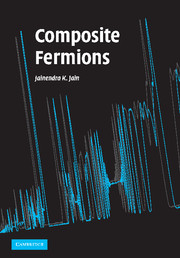Book contents
- Frontmatter
- Contents
- Preface
- List of symbols and abbreviations
- 1 Overview
- 2 Quantum Hall effect
- 3 Landau levels
- 4 Theory of the IQHE
- 5 Foundations of the composite fermion theory
- 6 Microscopic verifications
- 7 Theory of the FQHE
- 8 Incompressible ground states and their excitations
- 9 Topology and quantizations
- 10 Composite fermion Fermi sea
- 11 Composite fermions with spin
- 12 Non-composite fermion approaches
- 13 Bilayer FQHE
- 14 Edge physics
- 15 Composite fermion crystals
- Appendixes
- References
- Index
10 - Composite fermion Fermi sea
Published online by Cambridge University Press: 07 December 2009
- Frontmatter
- Contents
- Preface
- List of symbols and abbreviations
- 1 Overview
- 2 Quantum Hall effect
- 3 Landau levels
- 4 Theory of the IQHE
- 5 Foundations of the composite fermion theory
- 6 Microscopic verifications
- 7 Theory of the FQHE
- 8 Incompressible ground states and their excitations
- 9 Topology and quantizations
- 10 Composite fermion Fermi sea
- 11 Composite fermions with spin
- 12 Non-composite fermion approaches
- 13 Bilayer FQHE
- 14 Edge physics
- 15 Composite fermion crystals
- Appendixes
- References
- Index
Summary
The physics of the state at filling factor ν = 1/2 remained a puzzle for many years. Attention was redrawn to it inlate 1989/early 1990 by the work of Jiang et al., who reported a deep resistance minimum at ν = 1/2 incertainhigh-quality samples, and by certain anomalies at ν = 1/2 insurface acoustic wave absorption observed by Willett et al.. This time, with composite fermions available, rapid progress was made.
The lowest Landau level problem has no kinetic energy. When electrons transmute into composite fermions, the interelectron interaction energy transforms, in the simplest approximation, into a “kinetic energy” of composite fermions. (In general, not all of the Coulomb interaction transforms into kinetic energy, which leaves behind a residual interaction between composite fermions.) The CF kinetic energy manifests dramatically through the quantized Λ levels and the FQHE at ν = n/(2pn ± 1). These sequences terminate into ν = 1/2p in the limit of n → ∞. Should composite fermions exist in this limit, the magnetic field experienced by them vanishes. Motivated by the experiments mentioned in the preceding paragraph, Halperin, Lee, and Read (also see Kalmeyer and Zhang) made the striking proposal that composite fermions form a Fermi sea here, called the CF Fermi sea:
an infinite number of filled Landau levels = Fermi sea, (10.1)
an infinite number of filled Λ levels = CF Fermi sea. (10.2)
- Type
- Chapter
- Information
- Composite Fermions , pp. 286 - 306Publisher: Cambridge University PressPrint publication year: 2007



